When to harvest onions from the garden: optimal timing
Onions are an extremely valuable product. If you dispose of this wealth correctly, that is, if you correctly collect it and organize the correct storage, then it can be usefully eaten, since it will practically not lose its healing properties during the winter.
Well, next we'll talk about when to harvest onions and lay them in winter storage.
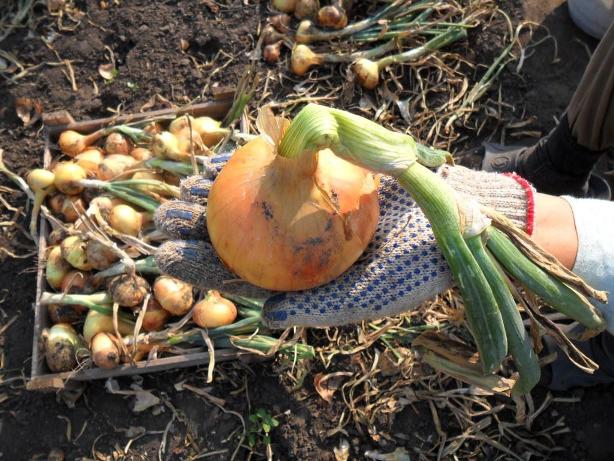
Content
Features of harvesting onions
How long the onion is harvested depends on how long it will be stored in the winter. There are a number of signs that determine the following factors affecting the quality of the harvested product:
- landing dates;
- climatic and weather conditions;
- variety and variety of culture.
Taking into account all the factors listed above, it is quite possible to organize the correct collection and further storage of this product.
Collection time
The most important point in onion harvesting is the timing. If the bow is removed too early, then the following phenomena occur:
- an insufficiently formed onion does not have time to be saturated with useful substances, therefore, it will not bring the intended benefit;
- unripe onions have too much moisture in the cells, so they are prone to decay;
- in unripe onions, the so-called "neck" is very thick and fleshy, which contributes to the loss of vitamins and nutrients during storage, as well as the penetration and reproduction of bacteria.
When collecting onions, it is necessary to take into account the fact that too late, the product also runs the risk of being spoiled, because the:
- overripe bulbs begin to re-start "arrows", which leads to the loss of nutrients, as well as a deterioration in the taste of the vegetable;
- from being in the ground for too long, cracks form on the scales, their integrity and protective qualities are violated, which also does not contribute to its long storage.
Important! The best way to determine when to harvest onions is their appearance.
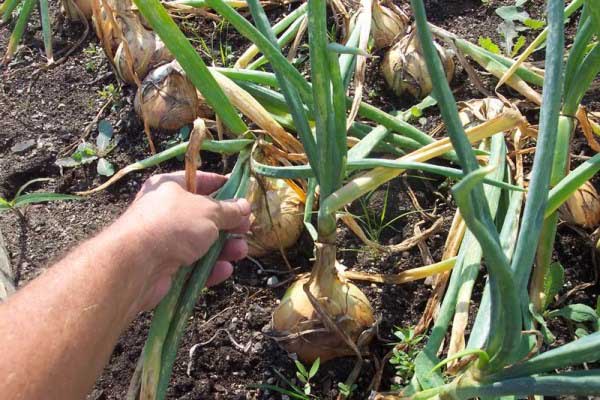
There are a number of signs by which you can tell exactly how ripe the bulbs are.
- "Feathers" should be yellowish brown and slope towards the ground. When they are already in the garden, you can start collecting.
- "Neck", that is, the place that connects the actual bulb with the feathers must be thinned and dry.
Important! When the harvest time is approaching, but the onions are not yet ready enough, you can slightly undermine the plants in the garden a week before harvesting so that they dry out a little.
The timing of planting of this culture is also very important. As a rule, full maturation occurs within two to two and a half months.
Climatic and weather conditions of collection
The most important indicator that it is time to harvest onions is weather and climate of the area. If the summer was dry, it is necessary to remove the onion early, since this culture loses nutrients with a lack of moisture, which reduces its “keeping quality”.
In a rainy and cold summer it is necessary to extend the harvest time for a couple of weeks, giving the crop the opportunity to ripen.
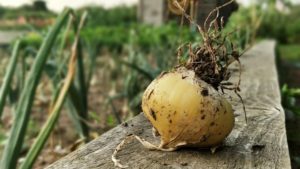
Since Russia is located on a very large territory, it is located in different climatic zones, which, of course, cannot but affect the timing of its harvesting. Further are given approximate harvesting times for this vegetable in different regions of Russia:
- The middle lane (Moscow region) - the second half of July - early August.
- South of Russia - July.
- Ural and Siberia - month of August.
It must be remembered that the above terms are conditional and indicative, since when deciding when to harvest, it is important to take into account all possible factors.
Timing of collecting various types of onions
Each of the varieties of this culture has its own ripening times, which can be easily calculated, starting from the moment of planting.
When buying seed, it is important to keep the packaging, which, as a rule, provides more accurate data on the timing of planting and collection of each specific variety.
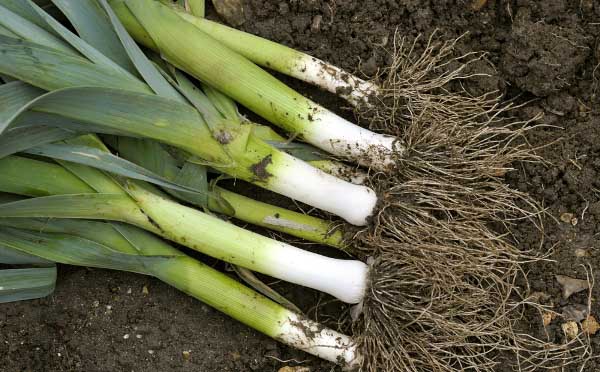
Thus, the leek must be harvested 1.5-2 months after planting. And onion and onion sets after about 3 months.
Video: when to remove onions from the garden for storage
Harvesting procedure - step by step instructions
The procedure and sequence of actions, as well as taking into account all the smallest nuances when collecting onions, predetermine the possibility of its long-term storage during the winter.
Optimal for this event is considered dry and sunny weather.
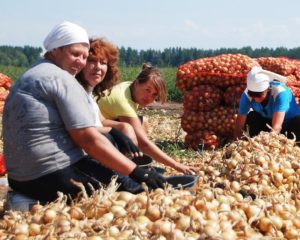
If the weather forecast foretells rainy weather, you need to prepare the onions for harvesting in about two weeks: bend the feathers to the soil surface. This will stop the bulbs from feeding the feathers, they will dry out, and you can start harvesting before the rains come.
Important! There is a common mistake common to novice gardeners who, in order to prepare onions for harvesting, cut their feathers. As a result of bacteria entering through the open sections, the bulbs become infected.Thus, most of the crop rots about a month after being laid in storage.
For the onion assembly procedure, you must acquire in advance the necessary set of tools:
- pitchfork;
- a large piece of oilcloth or polyethylene;
- some old blankets.
Important! It is highly not recommended to use a shovel for digging out onions. She can cut delicate onions, or simply damage the husk, which will reduce the "keeping quality" of the vegetable.
In especially loose soils, you can simply pull the onion out of the ground by pulling it out by the feathers. But this method is considered more laborious, since in the event of a feather break, the bulb will still have to be dug out.
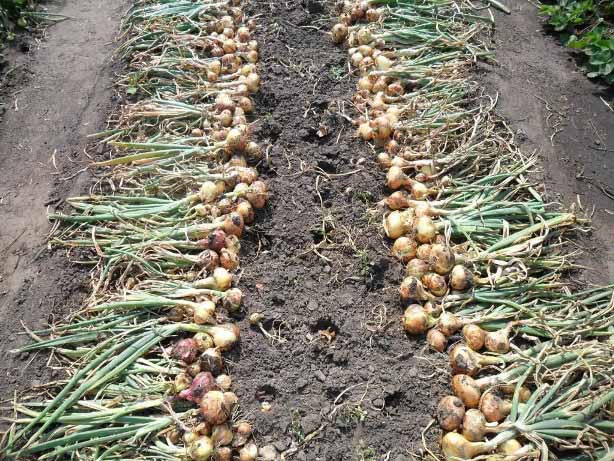
For large plantings of this culture, it must be remembered that the entire collection must be made within ten days. Longer periods can cause the entire batch to rot, as the last harvested bulbs will be more moist.
The collection procedure includes:
- digging bulbs out of the ground;
- removal of earth lumps from the surface of the bulb;
- drying;
- feather removal, or braiding.
Video: how to clean and store onions
Important! When removing the earth from the husk, in no case should the bulb be hit on the ground. At the same time, the integrity of the husk is violated, the onion itself loses its turgor. It is necessary to carefully remove the lumps of earth by hand, being careful not to damage the skin.
The drying process takes approximately two weeks. This is a very crucial moment, since an insufficiently dry vegetable is poorly stored. If the batch of vegetables is small, you can simply leave it in the garden. But drying will be much more effective if you spread the dug vegetables on plastic, covered with old blankets. This method will save the crop from parasites.
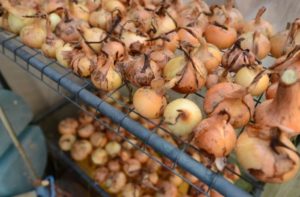
If the weather is rainy, it will take about three weeks to dry, and, of course, the onions will have to be laid out in a closed but well-ventilated area, for example, in the attic or in a barn.
Important! Professional manufacturers of this culture arrange special dryers, consisting of racks, about half a meter high. Wire nets are attached to the shelves, on which the crops are laid.
After the vegetables are dry, you must check their readiness for storage... For this, a number of methods are used.
- To the touch. A carefully dried vegetable has a smooth, thin peel. With strong pressure, it flakes and breaks off.
- Aurally. If the husk rustles, then the drying was successful.
After the drying phase, it is very important to sort out the crop, removing "empty" and rotting vegetables that can ruin the entire batch. Those copies that are suitable for storage must be freed from the pen.
Important! When pruning feathers, you should leave about three to four centimeters of dry stem.
There is a method in which dry stems are not cut off, but braided into braids. This method allows for the collection of large bundles of onions, which are subsequently suspended from the ceiling in the store.

